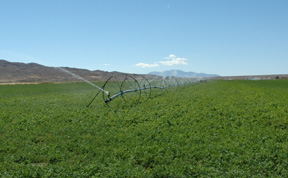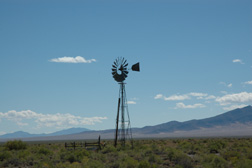Southern Nevada Water Authority’s water development project in Snake Valley causes concern in Utah

A view of Snake Valley looking westward from a point north of Garrison, Utah towards the Southern Snake Range. Wheeler Peak (13,065 feet), located within the Great Basin National Park, is the highest peak viewed in the picture. Stretching for about 100 miles, the Snake Valley is divided by the Utah-Nevada border. In terms of land area, most of the Snake Valley lies within Utah; however according to the Utah Geological Survey based on previous studies, most of the recharge water for the Snake Valley aquifers likely occurs along this mountain range located mostly in Nevada. The proposed SNWA wells are located on the Nevada side of the valley about 15 miles south of Great Basin National Park.
LeRoy W. Hooton, Jr., Director Salt Lake City Department of Public Utilities
September 22, 2006
The Southern Nevada Water Authority (“SNWA”) is moving forward with its proposed “Clark, Lincoln and White Pine Counties Groundwater Development Project (“Project”)” that would tap groundwater supplies from seven hydrological basins and convey this new water resource 200 miles southward to the thriving Las Vegas area. Costing about $2 billion, SNWA plans to drill 146 water production wells in south central and southwestern Nevada that will produce up to 200,000 acre-feet of new water supply. Receiving just over 4-inches of annual precipitation, the Project will allow SNWA to meet its future water needs for one of the driest and fastest growing areas in the United States.
The SNWA Project has raised concerns in Utah. Most of the groundwater development occurs within the boundaries of Nevada, except one segment of the Project, which will draw 20,000 – 25,000 acre-feet of water from Snake Valley located in eastern Nevada and western Utah – with most of the valley located on Utah’s side of the border. Also of concern is the belief that the groundwater aquifer in Spring Valley, located west of Snake Valley, is connected to the Snake Valley aquifer, which may further adversely impact Snake Valley ground water levels.
At a recent Utah Legislature Water Issue Taskforce meeting held at the Jordan Valley Water Conservancy District, SNWA general manager Patricia Mulroy extolled SNWA’s efforts to conserve water and make the case that the Project was necessary. “We view water conservation as a new water resource,” said Mulroy. “It’s more than the right thing to do, it’s survival for us.” She noted that SNWA has spent $60 million in rebates and removed 73 million square feet of grass. One-hundred percent of the indoor wastewater is treated and returned to Lake Mead where it is credited towards SNWA’s Colorado River allotment or reused for outside irrigation. According to Mulroy, despite its conservation efforts that have reduced the per capita consumption from 340 to 265 gpcd, SNWA will need additional water by 2015 when its existing resources will be exhausted.
|
SNWA is on the record stating that they will balance the hydrological systems in a responsible way. As part of the Project, water level monitoring facilities will be constructed to evaluate the impact of pumping on the groundwater basins.
Lt. Governor Gary Herbert and Utah State Engineer Jerry Olds have both stressed that Utah’s water rights will be protected. State Engineer Olds, in an interview on the KSL Doug Wright Show said, "It’s Utah’s intent to protect existing water rights under the laws of the State of Utah and protect Utah’s interests in the development of that [Snake Valley] resource.” However, there is interest in cooperating with Nevada. Last March, now retired Utah Division of Water Resources director Larry Anderson said he supported Southern Nevada’s efforts to develop instate groundwater rather than Las Vegas looking northward for additional Colorado River water in the Upper Basin or challenging the compact.
The focus on Snake Valley has sharpened in recent months, when it was rumored that Nevada and Utah water officials were preparing to sign the agreement required under the congressional legislation entitled, “Lincoln County Conservation, Recreation and Development Act of 2004 (“Act of 2004”),” which allows SNWA to construct the Project on federal lands. Language included in the Act of 2004 requires both states to enter into an agreement dividing up the Snake Valley groundwater. Opponents of the Project expressed concern that the agreement is premature, as the studies and Environmental Impact Statement (“EIS”) were not yet completed.
The Bureau of Land Management is responsbile for preparing the EIS for the Project. The U.S. Geological Survey, Desert Research Institute and the State of Utah represented by the Division of Water Rights are conducting the studies necessary to complete the EIS. Also, supplementary studies by the Utah Geological Survey are underway with a focus on Utah.
On September 11, 2006 four federal agencies studying the Spring Valley component of the Project withdrew their protests, stating they were satisfied that with an agreement with SNWA the
|
Currently, the Nevada State Engineer is holding hearings on the project’s water right filings. Ostensibly, Nevada and Utah water authorities are negotiating the two-state agreement. Opponents to the project are still holding out for the completion of studies and EIS to determine the safe yields of the Project. Both Salt Lake newspapers have written editorials urging that the studies be completed before decisions are made and the two-state agreement is signed.
Regardless of the final outcome of this Project, the issue of water will continue to be a major challenge facing western American. Over the past 50 years the population of the United States has doubled to 300,000,000 people. According to Census Bureau data, the southwestern states of Colorado, Utah, New Mexico, Arizona, Nevada and California collectively have grown at a rate 7.7 times faster than the nation as a whole from 1900 to 1990. These states continue to experience high growth rates, with Clark County, Nevada currently growing at the highest rate.

